|
|
|
Sort Order |
|
|
|
Items / Page
|
|
|
|
|
|
|
| Srl | Item |
| 1 |
ID:
124888
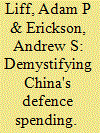

|
|
|
|
|
| Publication |
2013.
|
| Summary/Abstract |
China's limited transparency concerning its defence spending harms strategic trust, but foreign analysts often lose sight of important realities. Specific details remain unclear, but China's defence spending overall is no mystery - it supports PLA modernization and personnel development as well as its announced objectives of securing China's homeland and asserting control over contested territorial and maritime claims, with a focus on the Near Seas (the Yellow, East, and South China seas). This article offers greater context and perspective for Chinese and Western discussions of China's rise and concomitant military build-up through a nuanced and comprehensive assessment of its defence spending and military transparency.
|
|
|
|
|
|
|
|
|
|
|
|
|
|
|
|
| 2 |
ID:
124893
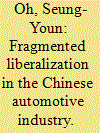

|
|
|
|
|
| Publication |
2013.
|
| Summary/Abstract |
This paper explains the extraordinary rise of the Beijing Hyundai Motor Company (BHMC), a joint venture between a state-owned enterprise run by the Beijing municipal government and Hyundai Motor Company. Within the span of three years, the BHMC soared to become China's second-ranked automotive manufacturer in terms of units sold. I highlight the role of the Beijing municipal government in creating favourable market conditions for the BHMC during its initial operation phase (2002-2005). The Beijing municipal government selectively adopted protectionist measures and liberalizing measures to promote its locally based company. I characterize this practice as fragmented liberalization, a system through which sub-national governments discriminately apply WTO or central government regulations to promote their local joint venture partner. In so doing, I also challenge the existing assumption that multinational companies are the drivers of economic liberalization, by showing Hyundai's support for local protectionism and industrial policy at the sub-national level.
|
|
|
|
|
|
|
|
|
|
|
|
|
|
|
|
| 3 |
ID:
124897


|
|
|
|
|
| Publication |
2013.
|
| Summary/Abstract |
Taking a broader perspective to explore the relations between Taiwan's globalization, social justice issues and the DPP's political and economic nationalism, this study aims to understand the DPP's resurgence in local elections since 2008, and its defeat in the 2012 presidential election. Increasing capital flight from Taiwan to mainland China has contributed to Taiwan's rising unemployment and income inequality. Less privileged Taiwanese, having stronger nationalist sentiments and concerns about the Taiwanese government's open-door China policy, switched their support from the KMT to the DPP during the DPP administration of 2000-2008. Since 2008, the DPP's better balance between its political and economic nationalism has been instrumental in securing popular support, especially at the local level. Nevertheless, in the 2012 presidential election, the DPP failed to convince the majority of Taiwanese voters that its moderate political nationalism could maintain the significantly improved cross-Strait relations vital for Taiwan's economic revival under the current bleak world economic conditions.
|
|
|
|
|
|
|
|
|
|
|
|
|
|
|
|
| 4 |
ID:
124894
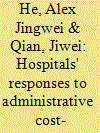

|
|
|
|
|
| Publication |
2013.
|
| Summary/Abstract |
The patterns of hospitals' behavioural changes in response to different insurance systems and payment arrangements have been well documented in the literature on health economics and policy. To understand these changes, it is necessary to look at the shifts in fundamental economic incentives. Meanwhile, hospital practices are also subject to adjustment when administrative tools are realigned. This article examines the dynamics of a health policy campaign started in 2005 by a Chinese provincial health administration that was committed to containing health expenditures using administrative measures. Through a combination of qualitative in-depth interviews and quantitative panel data analysis comprising 30 public hospitals in the sample, this article finds that by revising the structure of administrative measures on the supply side, the Chinese health bureaucracy is able to curb rapid cost inflation in the short term. However, while having to meet the cost control mandate imposed by the health administration, Chinese public hospitals still managed to defend their economic interests by engaging in various unintended opportunistic behaviour. This article analyses a panel database from Fujian province and reveals the strategies adopted by public hospitals and considers their implications for China's ongoing national healthcare reform.
|
|
|
|
|
|
|
|
|
|
|
|
|
|
|
|
| 5 |
ID:
124891
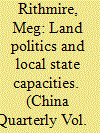

|
|
|
|
|
| Publication |
2013.
|
| Summary/Abstract |
Despite common national institutions and incentives to remake urban landscapes to anchor growth, generate land-lease revenues and display a capacious administration, Chinese urban governments exhibit varying levels of control over land. This article uses a paired comparison of Dalian and Harbin in China's north-east to link differences in local political economies to land politics. Dalian, benefiting from early access to foreign capital, consolidated its control over urban territory through the designation of a development zone, which realigned local economic interests and introduced dual pressures for enterprises to restructure and relocate. Harbin, facing capital shortages, distributed urban territory to assuage the losers of reform and promote economic growth. The findings suggest that 1) growth strategies, and the territorial politics they produce, are products of the post-Mao urban hierarchy rather than of socialist legacies, and 2), perhaps surprisingly, local governments exercise the greatest control over urban land in cities that adopted market reforms earliest.
|
|
|
|
|
|
|
|
|
|
|
|
|
|
|
|
| 6 |
ID:
124892


|
|
|
|
|
| Publication |
2013.
|
| Summary/Abstract |
Many studies raise doubts about the effectiveness of the institutions, programmes and instruments that shape the Chinese national innovation system. This article scrutinizes central-local interactions in the national Torch Programme that has governed a large group of high-technology zones since 1988. The Torch Programme's procedural practices challenge widely shared assumptions about the dirigiste character of Chinese innovation policy. It combines centralized definition of programme objectives with extensive local implementation experiments. As three case studies demonstrate, bottom-up policy innovations are effectively fed back into national programme adjustments and into horizontal policy diffusion. The array of organizational patterns and promotional instruments that emerges from competitive "experimentation under the shadow of hierarchy" (ESH) goes way beyond what could have been initiated from top down. We hypothesize that the procedural strengths displayed in the Torch Programme may provide better indicators of future innovative potential in China's high-technology zones than retrospective statistical indices and benchmarks that are derived from OECD experience.
|
|
|
|
|
|
|
|
|
|
|
|
|
|
|
|
| 7 |
ID:
124898


|
|
|
|
|
| Publication |
2013.
|
| Summary/Abstract |
Does empirical evidence support treating "nationalism" and "patriotism" as separate concepts in China and is there a relationship between strong nationalist/patriotic attitudes and foreign policy preferences? To analyse the construction of Chinese national identity, Chinese university students (N = 1346) took part in a survey in Beijing in spring 2007. The data supported the assumption of a conceptual separation between nationalism and patriotism. CCP members and students from rural backgrounds were more nationalistic than non-members and students with urban upbringings. Moreover, nationalism had a stronger link to foreign policy preferences than patriotism, and respondents with a greater degree of nationalism were less likely to favour international cooperation and more likely to prefer protectionist policies. The associations of nationalism and patriotism with foreign policy attitudes, and the contribution of other potential explanatory factors to the relationship between nationalism, patriotism and policy attitudes were explored with linear regression models.
|
|
|
|
|
|
|
|
|
|
|
|
|
|
|
|
| 8 |
ID:
124895
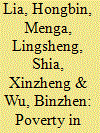

|
|
|
|
|
| Publication |
2013.
|
| Summary/Abstract |
We use the Chinese College Student Survey, conducted in 2010, to examine levels of poverty among students on China's campuses. With the poverty line defined as the college-specific expenditures a student needs to maintain a basic living standard on campus, we find that 22 per cent of college students in China are living in poverty. Poverty is more severe among students from rural or western parts of the country. With a targeting count error of more than 50 per cent, it is important that the college need-based aid programme be improved. Lacking other income sources, poor students rely heavily on loans and paid employment to finance their college education.
|
|
|
|
|
|
|
|
|
|
|
|
|
|
|
|
| 9 |
ID:
124889
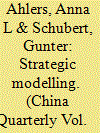

|
|
|
|
|
| Publication |
2013.
|
| Summary/Abstract |
Models, pilots and experiments are considered distinctive features of the Chinese policy process. However, empirical studies on local modelling practices are rare. This article analyses the ways in which three rural counties in three different provinces engage in strategies of modelling and piloting to implement the central government's "Building a New Socialist Countryside" (shehuizhuyi xinnongcun jianshe) programme. It explains how county and township governments apply these strategies and to what effect. It also highlights the scope and limitations of local models and pilots as useful mechanisms for spurring national development. The authors plead for a fresh look at local modelling practices, arguing that these can tell us much about the realities of governance in rural China today.
|
|
|
|
|
|
|
|
|
|
|
|
|
|
|
|
| 10 |
ID:
124890
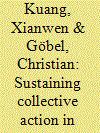

|
|
|
|
|
| Publication |
2013.
|
| Summary/Abstract |
In recent years there has been a proliferation of scholarship on protests and other forms of collective action in China. Important insights have been gained into how conflicts between social groups and local governments begin, which strategies and instruments protesters apply, and under which circumstances protests are likely to succeed or fail. However, comparatively little is known about the mobilizing structures and how such collective action can be sustained over a long period of time, in some instances over several years. Such perseverance would be remarkable even in a democracy, but it is more so in an authoritarian system where the risks of participating in collective action are higher and the chances to succeed much smaller. This article compares the development of public protests in two research locations and identifies four factors instrumental to overcoming the formidable challenges of sustaining collective action in China: the continuing existence of substantial grievances; the re-activation of strong social ties; the presence of unifying frames; and an adaptive protest leadership. The comparison shows that the last factor is particularly crucial: while the two villages were similar in all other respects, leadership in village B was far more adaptive than in village A, which goes a long way towards explaining why collective action could be sustained twice as long in village B.
|
|
|
|
|
|
|
|
|
|
|
|
|
|
|
|
|
|
|
|
|